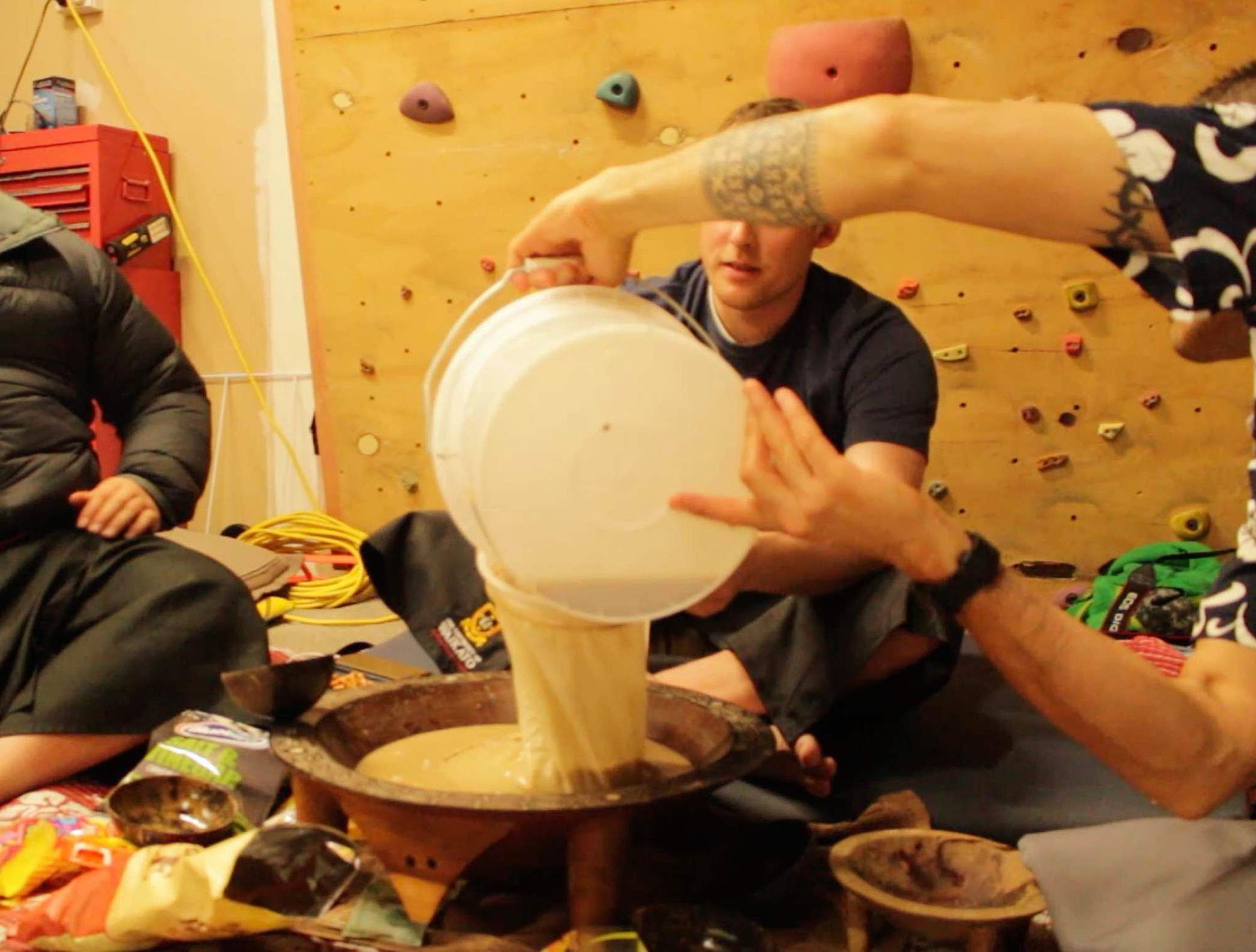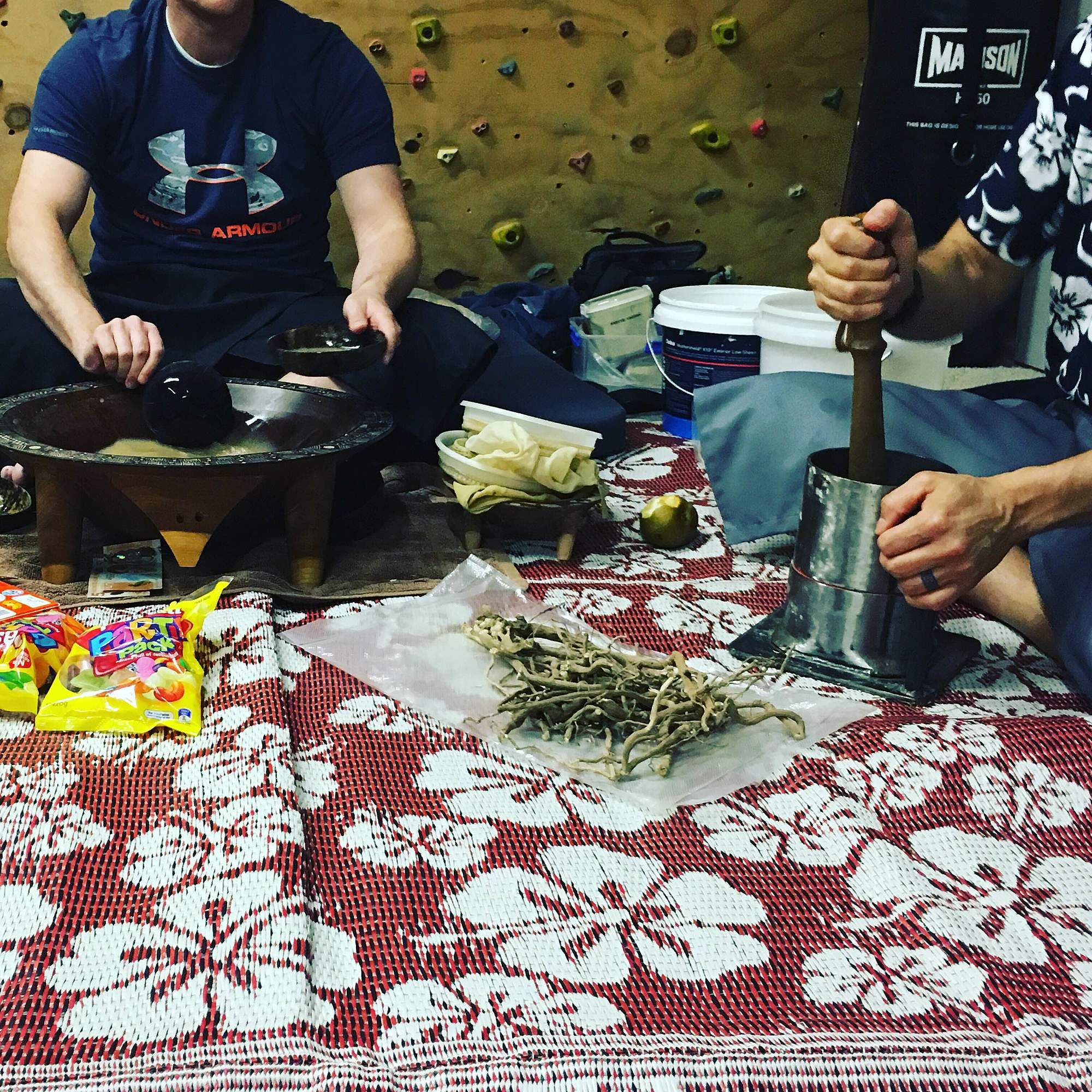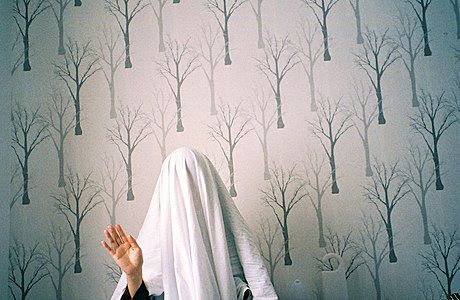Mormons, Curses, and Papālangi Visitations: New Zealand's Evolving Kava Culture
Harrison Christian joins a kava circle in Hamiton East
Dr Apo Aporosa is cross-legged on the floor, smashing dried kava roots with a mortar and pestle. He wears an aloha shirt and a formal Fijian skirt called a sulu vakataga. Laid out on the mat in front of him is a scraggly bundle of root-ends and a half-eaten pear, which he is using to chase the brew.
“Any time of day, I could take you to drink kava,” he says between strikes on the mortar. “It's happening all the time, but the average person walking down the street would never know."
“There are kava clubs everywhere,” agrees Edmund Fehoko, a Tongan PhD student, whose upright posture and serene half-smile recall a Buddhist monk right now. “The schooling of a lot of young people in Tonga is paid for by kava clubs in New Zealand.”
We watch Dr Aporosa going about his work; a source of frenetic energy in a room full of still bodies. Now he’s kneading the smashed roots in a strainer bag. Eventually Edmund says, “Taki taki,” and a coconut shell of brown water arrives in my hands. I clap once and chug it, then clap three times. The bitter drink fills my stomach and leaves my mouth numb.
The shell is passed to a tanoa, a ceremonial wooden bowl, from which more kava is served. There are five of us sitting in a circle in a garage in east Hamilton. I’m a stranger to Dr Aporosa and his friends, but the usual social rigmarole doesn’t seem to apply to our Friday night vigil. We’re listening to Bob Marley and talking openly as the root begins to work on us.***
The kava shrub is a member of the pepper family, grown for thousands of years throughout tropical Pasifika. The roots of the plant are used to create a non-alcoholic drink with relaxing psychoactive effects.
In New Zealand, kava is consumed by more than twenty thousand people on a Friday or Saturday night. It’s also growing in popularity among non-traditional users; raising questions about how they reconcile the beverage with their contemporary lives, and in some cases, with their religion.
Two of the men in our circle are teetotaling Mormons: Marty; a pālangi, lecturer in engineering, and owner of the garage we’re drinking in; and Daniel Hernandez; an indigenous Guatemalan and anthropologist.
The Church of Jesus Christ of Latter-day Saints - a religion founded in 19th-century America - has a health code which eschews alcohol, tobacco and even hot drinks like coffee and tea.
"There is no official stance from the Church on kava, but in places it's banned,” Daniel explains. He’s a jovial presence sitting to my right; pony-tailed and unshaven; physical traits which are unusual for an orthodox Mormon (long hair and beards are discouraged in the Church’s missionary and seminary orders, and rare outside of them).
Daniel grew up in Utah, the US state known as the “Mormon Mecca,” and the centre of the religion’s cultural influence. It’s also home to 40,000 Pacific Islanders. An immigrant of Mayan ancestry, he gravitated to other minorities, and was introduced to kava through his friend, a Tongan church-goer.
More than a decade later, Hernandez is still attending kava sessions, and studying the plant’s relationship with traditional Tongan songs and identity for his PhD at Auckland University. He is selective about where, and with whom, he discusses his research.
Mormon Pasifikans who drink kava inevitably confront a divide between their cultural heritage and their modern American faith.
"This is how we always talk around kava,” he says, “But at Church, we're quite restricted. Outside of the kava circle and outside of academia, I have to be more careful about what I say."
Mormon Pasifikans who drink kava inevitably confront a divide between their cultural heritage and their modern American faith. Weeks earlier, I'd met a Samoan called Shane during a kava session in Daniel’s Auckland home. Sitting on the living room floor with his wife dozing on the couch behind him, Shane said he felt disillusioned by the lack of diversity in the upper echelons of Mormonism. The international leadership are all white male Utahns.
“Since I've been introduced to kava, I've realised how much my white Mormon upbringing has alienated me from my spiritual Samoan background," he’d told us.
The Pacific Islands were one of the first areas to be massively evangelised by the Church. In Tonga, it’s claimed more than half the country’s population are members.
According to US historian James Axtell in his The Invasion Within: The Conquest of Cultures in Colonial North America, when Europeans convert to Christianity, they remain European; when indigenous people join the church, they're expected to commit “cultural suicide.”
In the case of Pasifikans, conversion had meant abandoning traditional spiritual beliefs and practices - suddenly looked down on as primitive, backward, profane - in exchange for Western imaginings of a God moulded around Eurocentric ideals.
Dr Aporosa knew of Mormons who’d been questioned by the Church about their kava drinking, particularly in the last 12 months. One friend of his was accused of hosting “kava parties,” which the leadership seemed to perceive as raucous, alcohol-fuelled events.
***
I experienced a sinking disorientation as my writing subject seemed to become more complex than was convenient or comfortable. It had been tempting to portray Hernandez as a renegade Mormon who was taking advantage of a scriptural loophole to get buzzed. The drink was mildly intoxicating, but I sensed there was something else at work - a murky convergence of the drink’s social, cultural and spiritual uses - which interested Shane, Marty and Daniel, rather than its superficial effects.
I struggled to relate to it. My secular Western upbringing had led me to approach substances like alcohol, caffeine and nicotine purely in terms of how effectively they crossed the blood-brain barrier. And it seemed ironic that all of those drugs were once used by indigenous peoples in a spiritual context.
I’d been drinking kava in the place of alcohol for a couple of months. I found I could buy it over the counter in unmarked bags at certain Mt Roskill dairies, but mostly I was ordering it from a New Zealand-based supplier in instant form. I was mixing it into a mug of water and knocking it back; often alone but sometimes sharing it with my girlfriend or flatmates, whose reactions were varied but generally positive.
The supplier website “Kava Boutique” is co-operated by a Polish man called Zbigniew. Poland is the only country in the world in which kava is unequivocally banned, and perhaps the persecution of users in Zbigniew’s homeland has driven him to dispense kava in New Zealand with a rare meticulousness and zeal. He scours the islands for the purest strains, then gets them lab-tested to ensure quality; honing in on the plant’s most desirable chemotypes.
When I met him roadside one afternoon to pick up a Hawaiian grind, he described in his clinical Slavic accent a process of testing several variants from a specific and kava-renowned region before he'd been satisfied.
The root from the Mt Roskill dairies had been hit and miss – either disappointingly weak or nauseatingly potent, and in one case, causing a strange reddish pigmentation around my eyes - but Zbigniew sold the good stuff.
“I call drinking dairy kava the ‘Pacific roulette,’” he said in one of our email exchanges. “Once in a while you can find something decent, but most of it is total shite.”
Dr Aporosa is intrigued to hear I've been drinking by myself. In the thousands of times he’s consumed the brew, the former police officer and soldier turned eminent kava researcher has never once been alone.
I'd tried a few of Zbigniew’s varieties. There was Fijian Sunset; "praised for both its impressive headiness and deeper, longer lasting, body-melting effects;" and Happy Tongan; "strong and heady with pronounced cheerfulness and energy." Sometimes, usually on an empty stomach, the kava was uplifting and euphoric; bringing feelings of peace, optimism and even strength.
A clarity and spaciousness can be experienced when a mind usually weighed down by anxious thoughts is suddenly rid of them, similar to that feeling of leaving a city and taking in the vastness of an unobstructed sky from more natural surrounds. The drinker can become sensitive to light and sound, colours may be enhanced, and there's a trademark numbing of the mouth. The drink is sedating without disrupting awareness.
There is no perceivable hangover, but the drinker is likely to feel relaxed and refreshed the following morning; having enjoyed a deep and easy sleep, possibly accompanied by vivid dreams.
But Dr Aporosa is intrigued to hear I've been drinking by myself. In the thousands of times he’s consumed the brew, the former police officer and soldier turned eminent kava researcher has never once been alone. It’s against cultural protocol.
“For Fijians, those who drink kava alone are perceived as people who do witchcraft,” he says after finishing his shell. “It's potentially abusing the strength of the plant; there's no accountability."
“What that means,” Edmund says gravely, suddenly commanding the full attention of the circle, “is you should never drink kava by yourself.”
The circle erupts into laughter. I notice I’m laughing too, and wearing a persistent grin. Every 15 minutes or so, someone says, “taki taki,” and the kava is served, and I take my shell gratefully. I’m buoyed by waves of cheerfulness as the conversation drifts into further tangents. Whenever we arrive at a new topic, Dr Aporosa pausescomically, before launching into another passionate speech.
***
Kava is perhaps the most universal icon of Pasifika culture, and thought to be imbued with mana. It is presented, mixed and drunk to acknowledge births, deaths, arrivals and departures.
"Kava both possesses and transfers mana. If you were sick, we could all drink kava for you tonight,” Dr Aporosa tells me. “In Fiji, it is even possible to curse someone using kava - by throwing a bowl of it outside and saying certain things.”
He believes the first Polynesian migrants to New Zealand a thousand years ago brought kava with them, but that it failed to grow in the colder climate.
It had already travelled across the Pacific with Polynesian explorers, from Vanuatu to Hawaiiki, or present day Raiatea in French Polynesia. It does not produce seeds and can only be grown using cuttings, so these early sailors played a critical role in its dispersal.
"It was carried on long voyages, because it was believed the mana would keep the travellers safe. And when they arrived at their destination, they presented it as an acknowledgement.”
In language, the links remain. The word kawa in Māori means “marae protocol,” which would accord with kava having once been used in a ceremonial context.
Kava was given to hosts by visitors, then mixed and drunk to bring about mutuality and equality between presenter and recipient; the removal of tapu and creation of noa.
In language, the links remain. The word kawa in Māori means “marae protocol,” which would accord with kava having once been used in a ceremonial context.
Dr Aporosa believes metaphorical kava use has continued in Maori cultural practice; for example, the consumption of kai during pōwhiri to create noa; and the medicinal use of a related plant species which Maori settlers named kawakawa, perhaps in memory of the kava plants they'd tried unsuccessfully to grow here.
Though it’s the product of a different plant, endemic to Aotearoa, kawakawa tea is a peppery beverage with similarly mouth-numbing effects, used for a variety of ailments and as a general health tonic.
***
Around 10pm the door swings open and five men crowd into the garage. They’re all Mormons who've come from a ball organised by a “stake,” or group of local congregations. The men have dropped their wives home and come over to drink kava. They pull up deck chairs and join the circle, giggling at text messages from their wives: where had they disappeared to?
When a sixth man comes in soon after, he’s met with boisterous applause. "Jesus is here! Jesus is here!" he proclaims, receiving jeers from the group. Then he moves to the opposite end of the garage, where he busies himself putting on a ta'ovala. He ties it around his waist with a kafa rope.
The Tongan sits down beside me and introduces himself as Clive (a pālangi name, he admits). Despite his theatrical entrance, he is earnest and soft-spoken. He explains he’s wearing the ta'ovala out of respect for his two teenage sons, who are also drinking with us.
"I'm proud that my sons want to drink kava,” he says, gesturing to one of them, who’s already reclining in a deck chair and plucking an acoustic guitar. "It means I know what they're doing - they're not out getting into trouble.”
Clive has always been open about his kava drinking - even during his time as bishop of a local Tongan congregation.
"It's a way of life; it's what I do. I just tell people, if you think kava is interfering with my faith, then you let me know."
Now there are 11 of us in the circle, the dynamic becomes more lively. There are social workers, managers, rugby trainers and students. Conversation springs up everywhere; limited to two or three men, or involving the whole circle as one person relays a joke or story.
In one moment the talk is low and serious; in the next it’s light and cascades into laughter. Worn hymn books are passed out and Tongan hymns are sung; there is plenty of bantering in the interim, but the songs themselves are sung as if in church.
It’s midnight. I relax further into the setting as the last vestiges of my self-consciousness drain away. I no longer feel like an outsider; a pālangi; a journalist. Dr Aporosa comes and goes from the circle to get more water, stepping around people and excusing himself with “tulou, tulou.” Finally there’s a lull, and everyone sits in a benign silence. Then Edmund says, “taki taki,” and more kava is served.


